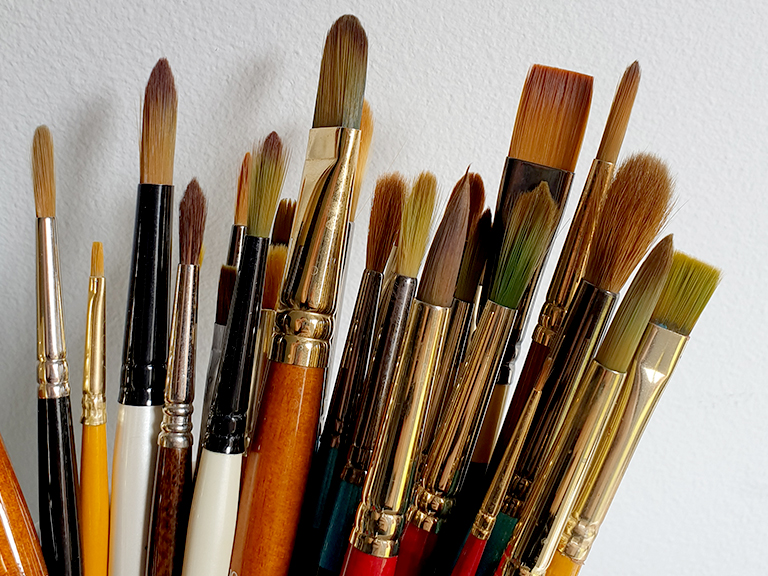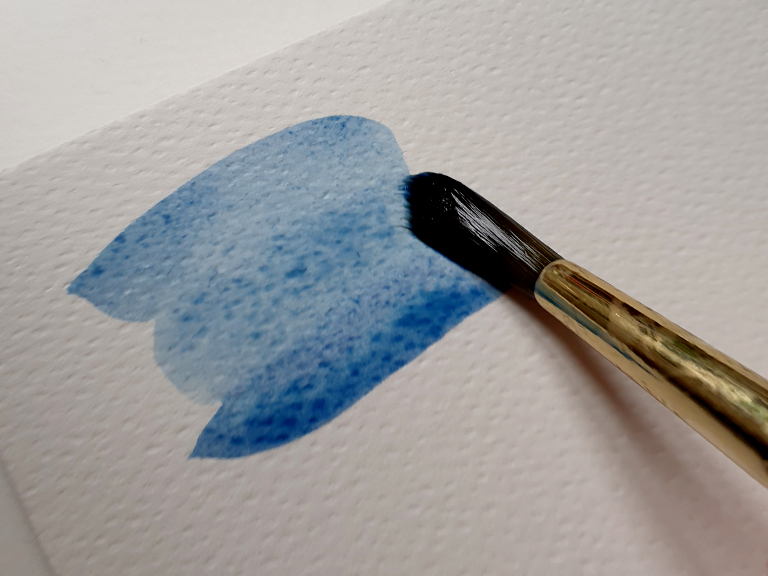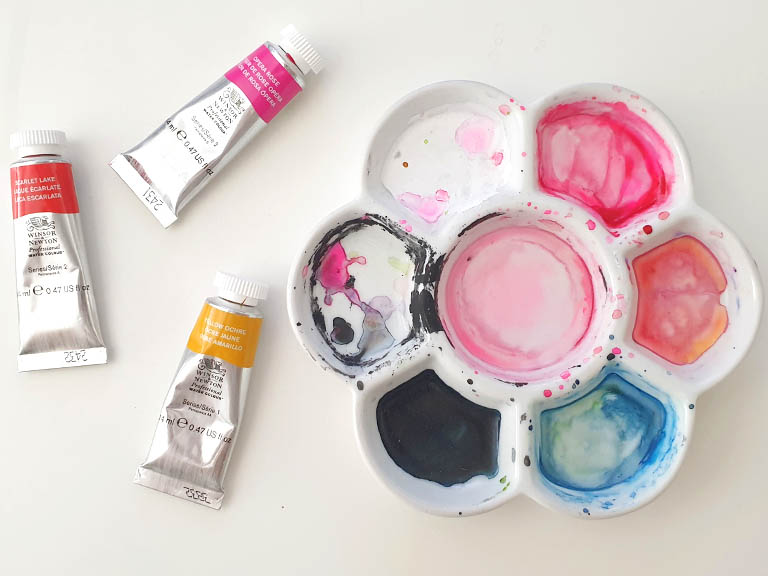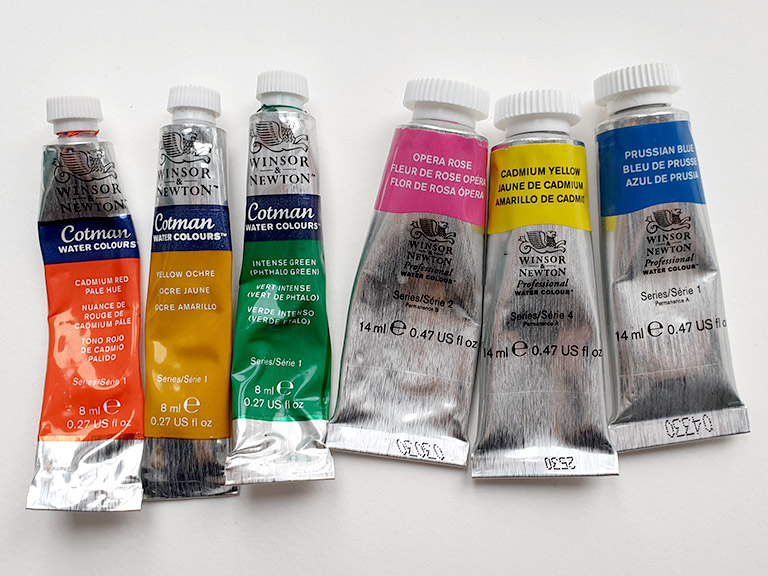When you walk into an art shop, you’re often greeted with a wall full of watercolour paints. There are so many different types, brands and colours – how do you know where to start?
Buying watercolour supplies can be expensive, especially when you get it wrong. This guide will walk you through the different options when it comes to watercolour paint, so you know exactly what you’re buying. Say goodbye to paint supply paralysis!
Disclaimer: I’ve been a watercolour artist for many years and all of these recommendations are my own reviews. I don’t accept payment or gifts from brands and don’t earn commission. I and have paid for these with my own money and only recommend brands and products I use and love within my own work.
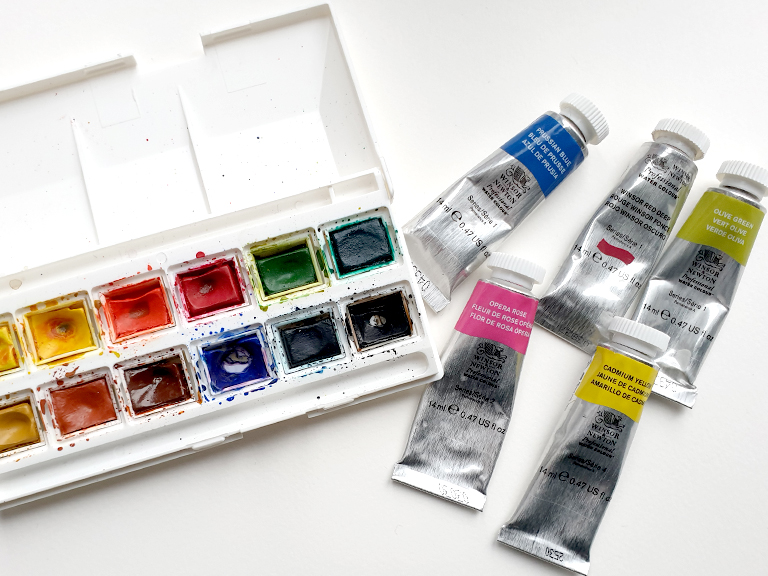
What is in watercolour paint?
Watercolour paints are made up of pigment, the part that gives them colour, along with binders and other additives that control things like texture.
The first thing you’ll notice about watercolour paint in an art shop is that it quickly gets expensive. The main driver behind price is the amount of pigment and its quality and purity. Cheap watercolour paints use more binders and additives to bulk out the paint so it requires less pigment, and also use cheaper and lower-quality pigments. This makes them cheaper to buy but also creates colours that seem chalky, dull and faded.
The more expensive paints use less binders and higher levels of pigments. This creates richer and more vibrant colours, but at a higher cost.
Watercolour paints also seem expensive because they’re so small! While it doesn’t feel like you get much paint for your money, remember that a tiny amount of paint goes a long way. Even a little half-pan can last you months.
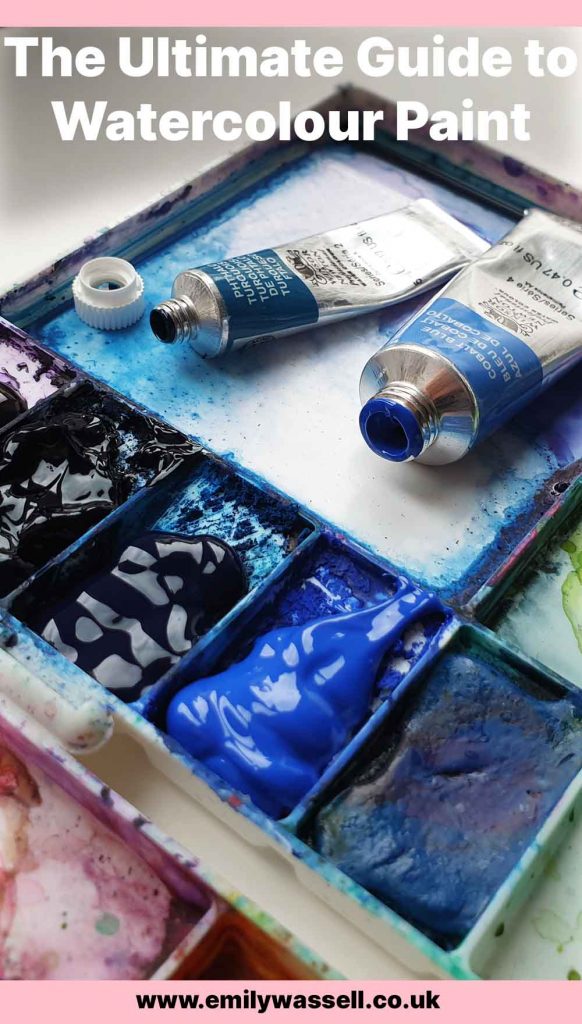
Student and professional watercolour paint
Most watercolour brands have two types of paint – a student and a professional range. The student range is a good watercolour paint for beginners, though some people prefer to start straight away with professional-grade paints.
Remember that the paints you use are down to personal preference. I see many people recommending that watercolour beginners buy good supplies, and the reason makes sense. If you buy cheap supplies and get bad results, you’ll get frustrated and discouraged and soon stop painting. And it wasn’t you that was bad – it was the supplies!
However, I also hear from people who buy good supplies and then don’t want to practice because they can’t bear to waste them. So here’s my advice – if you really want to start out with the best, go for it. If the cost or worry will hold you back, start with student grade paints and upgrade when you feel more confident. After all, student paints are designed for people who are learning!
And make sure to get good quality watercolour paper – it can make a big difference to the results.
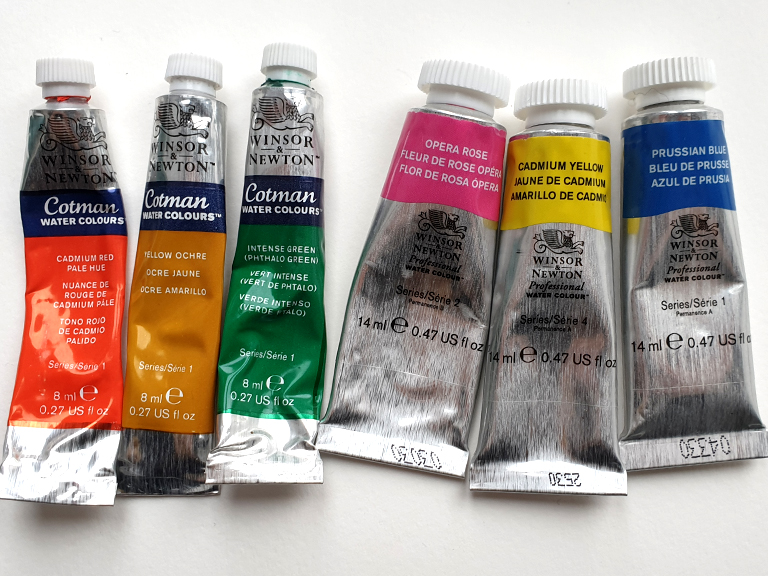
Pans or tubes
There are two formats to buy watercolour paint – pans or tubes. Pans are small plastic containers that hold dried paint which is activated by adding water. They come in full pan or half pan sizes, sometimes called doubles and singles. Single half pans are the most common for watercolour sets.
Tubes contain watercolour in a more viscous liquid form. Some people like to paint straight from the tube, but this can risk wasting the paint by using too much. Remember that you only need a tiny amount of paint at a time!
The best way to make the most of tube paints is to squeeze out some paint, let it dry and come back with your watercolour paintbrush to reactivate it with water when you want to paint. You essentially dry it out and use it like a pan. You can use tubes to fill empty pans, or squeeze them out onto a palette of your choice.
Buying watercolour sets
Many beginners like to use a watercolour set, containing a number of paints already made up for them. This is a really great place to start, as the sets are designed to give you a good range and choice of colours. Sets often come as half-pans in a palette with a lid that converts into a mixing tray.
There are dozens of different watercolour paint sets to choose from. Some contain a general range of colours, while others build sets around different colour themes. If you’re struggling to choose, I recommend buying a small or medium general paint set, and avoiding ones with huge numbers of paints – you’ll probably never use at least half of those colours!
If you buy a set made from detachable pans, you can remove the plastic containers when they’re empty and replace them. You can also customise your palette by removing colours you don’t like and filling the space with others.
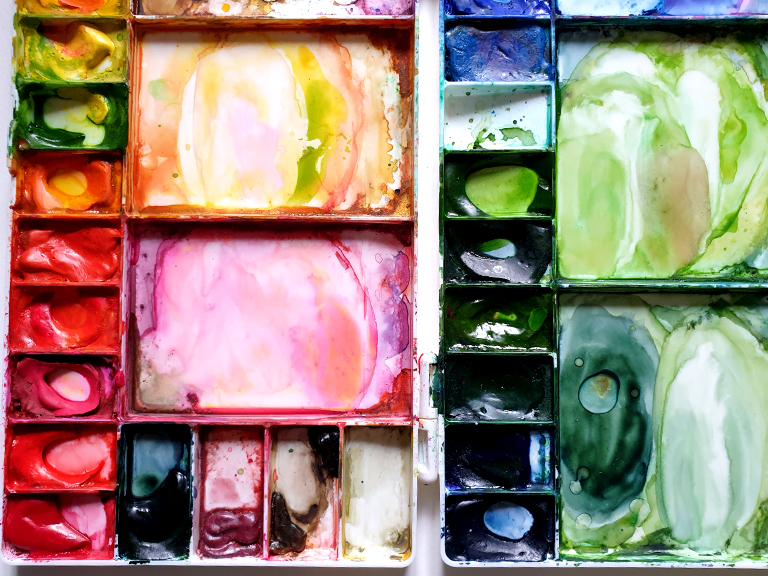
Setting up your own palette
If you want to set up your own watercolour palette, you’ll need to choose the colours individually. This can be a process so don’t worry about getting them all at once!
Start with the primary colours – yellow, red and blue. I recommend getting a warm yellow like cadmium yellow or yellow ochre, as well as a cool hue like lemon yellow. Add the secondary colours next – green, purple and orange. Add a brown and black for darkening your mixes and you’ve got the makings of a simple palette.
You can also choose colours based on what you love to paint. If you love florals, you’ll want a choice of pinks, reds and greens for the leaves. If you love landscapes and urban art, you’ll want more browns and umbers.
If you’re feeling stuck or overwhelmed, my top tip is to pick the colours that you’re most drawn to.
What are the best watercolour paints?
This question is hard to answer! Art supplies are a totally personal preference – what one person loves, you might hate, and vice versa. To find the best paints for you, you might need to test a few brands and ranges to see what you like best.
The best place to start is to find a reputable watercolour brand – these are the most common ones:
- Winsor & Newton
- Sennelier
- Schmincke
- Daniel Smith
- Art Philosophy
There are hundreds more smaller brands available, as well as independent and artisan paintmakers. My best advice is to find a reputable brand that is widely available where you live – watercolour paint is already expensive without having to pay shipping from the other side of the world!
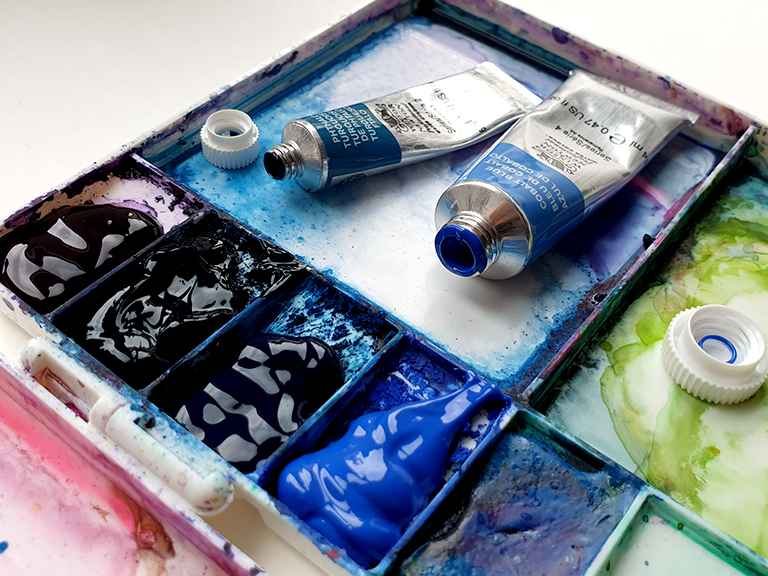
How do you compare watercolour paints?
If you want to compare paints from different brands, you need to look at the packaging. Good paint brands will provide details of what’s in their paints and how they behave over time. If you can’t find this information on the packaging or their websites, it means that the paint is not high quality.
Don’t worry if you find this a bit technical! You don’t need to know this to buy paints or paint sets. But if you want to understand exactly what you’re getting, this section will show you how to read the labels.
Pigment number
The paint should tell you what pigment or pigment mixes it contains. This is a number that starts with P, for example Cobalt Blue is PB28. This code means the pigment is blue (PB) and the pigment number is 28. Yellow Ochre is PY43 – pigment yellow, number 43.
If you see multiple P numbers, that means the paint is made with a mixture of pigments. This isn’t a problem when used on its own, but when mixed with other paints, especially if they also have multiple pigments, it can create a duller and muddier tone.
The pigment number is the best way to match paints from different brands. For example, most brands have a paint named Prussian Blue, but the colour can be totally different for each paint maker. If you want to find the same colour from a different brand, find one with the same pigment number, even if the name is different.
Lightfastness
This is another score given to watercolour paints. It tells you if the pigment used is known to fade over time when exposed to sunlight. All this means is that if you want to display your work on the wall or sell it for other people to display, you want paint that has a good lightfastness.
Paints with poor lightfastness are sometimes called fugitive watercolour pigments. They often fade, darken or change hue when exposed to sunlight. They are usually historical pigments and many watercolour brands don’t use them anymore. Most have been replaced with modern and synthetic pigments that hold their colour much better – you’ll see this if a paint name contains ‘new’ or ‘permanent’, such as New Gamboge or Permanent Rose.
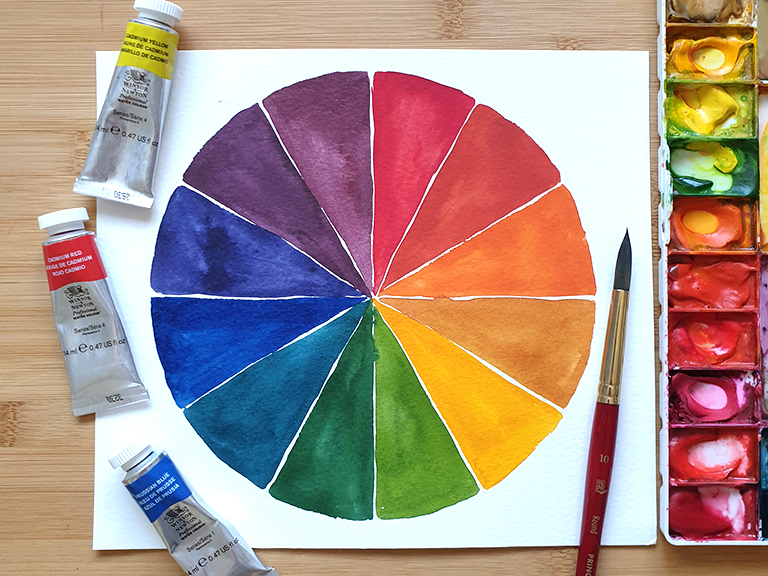
Transparency
This tells you whether the paint is transparent or opaque, or somewhere in between. It’s fine to have a mix of both as they create different effects.
Series
Some paint makers like Winsor & Newton also have a series number. These are bands of watercolour pigments, depending on how expensive they are. Rarer or more costly pigments will be in a higher series band, making that paint more expensive. The cheapest pigments are series 1, and the most expensive are series 5.
Hue
If the paint name contains the word ‘hue’, such as Cadmium Yellow Hue, this means it’s an approximation of the real colour. The paint doesn’t contain real cadmium yellow pigments, but alternatives mixed to create a similar colour. Hue paints are imitations of the real pigments but they’re not necessarily inferior – sometimes they’re just a more stable, modern version of a traditional colour. If you want to buy a hue colour, look for a single pigment version for the best quality.
A note on cadmium pigments
Cadmium is a traditional pigment that creates rich yellows, reds and oranges. It’s used in many types of paint including watercolour. However, it can be controversial for artists because it’s been shown to be toxic when ingested by animals. Some countries have added health warnings to cadmium paints, though the European Union (where I live in the UK) have deemed it safe.
I use and love cadmium pigments but if you have any concerns, you can find hues and close alternatives from most brands. And though it should go without saying, if you do use cadmium paints please don’t ingest them in any way!
What watercolour paints do I use?
I use professional grade watercolour paints by Winsor & Newton. Note that I am not an ambassador of the brand, nor sponsored by or affiliated with them in any way. I answer this question only because so many of you ask me.
I use Winsor & Newton because they are a professional and long-established paint maker, their paints are very good quality, and because they’re a British brand – I like to support local businesses where possible. I buy all my own paints and prefer to get them in tubes and squeeze them out onto a big plastic palette.
If you want to know my full colour list, download my free watercolour supply guide. The guide contains all my supply secrets and everything I use on a daily basis, as well as tips for finding the best beginner supplies too!
When choosing colours for your watercolour palette, consider the primary colours (red, blue, yellow), along with a range of secondary and tertiary colours. Think about the subject matter you enjoy painting and select colours that will allow you to capture a wide range of tones and hues.
Transparent watercolour paints allow light to pass through, creating luminous and layered effects. Opaque watercolour paints have more coverage and do not allow light to pass through. Most watercolour paints have a good level of transparency,
To mix colours in watercolour painting, start with small amounts of paint and adjust gradually until you achieve the desired shade. Mix similar colours for adjustments, or opposite colours for muted browns and greys.
You can use watercolour paints on other types of paper, but the results won’t be the same. I love painting on toned drawing paper, but the colours are more faded and it dries much more quickly. Try testing mixed media paper, coloured paper and some types of drawing paper.
To make watercolour paints more vibrant, use less water and more concentrated paint. To make them less intense, dilute the paint with more water or mix in a complementary (opposite) colour, for example adding a touch of red to green to make it muted.
High-quality watercolour paints are usually called ‘Professional’ and are made from high-quality pigments and binder. They have excellent lightfastness, meaning they resist fading over time. Look for reputable brands and check reviews or ratings to ensure the quality of the paints.
To make watercolour paintings last longer, use professional grade lightfast paints, and high-quality watercolour paper. Avoid displaying the artwork in direct sunlight and protect it with a UV-resistant varnish or frame it behind UV-protective glass.
Store watercolour paints in a cool, dry place away from direct sunlight. Keep the paint tubes tightly closed to prevent them from drying out. For pans, they can sometimes dry or crack if left for a long time, but they are easily rehydrated by adding more water when you’re ready to paint.
Find the best watercolour supplies
Download my free watercolour supply guide
Feeling overwhelmed and confused by watercolour paints, papers and brushes? Download my free guide filled with insider info, including a list of good supplies for every budget, and my complete supply list!
